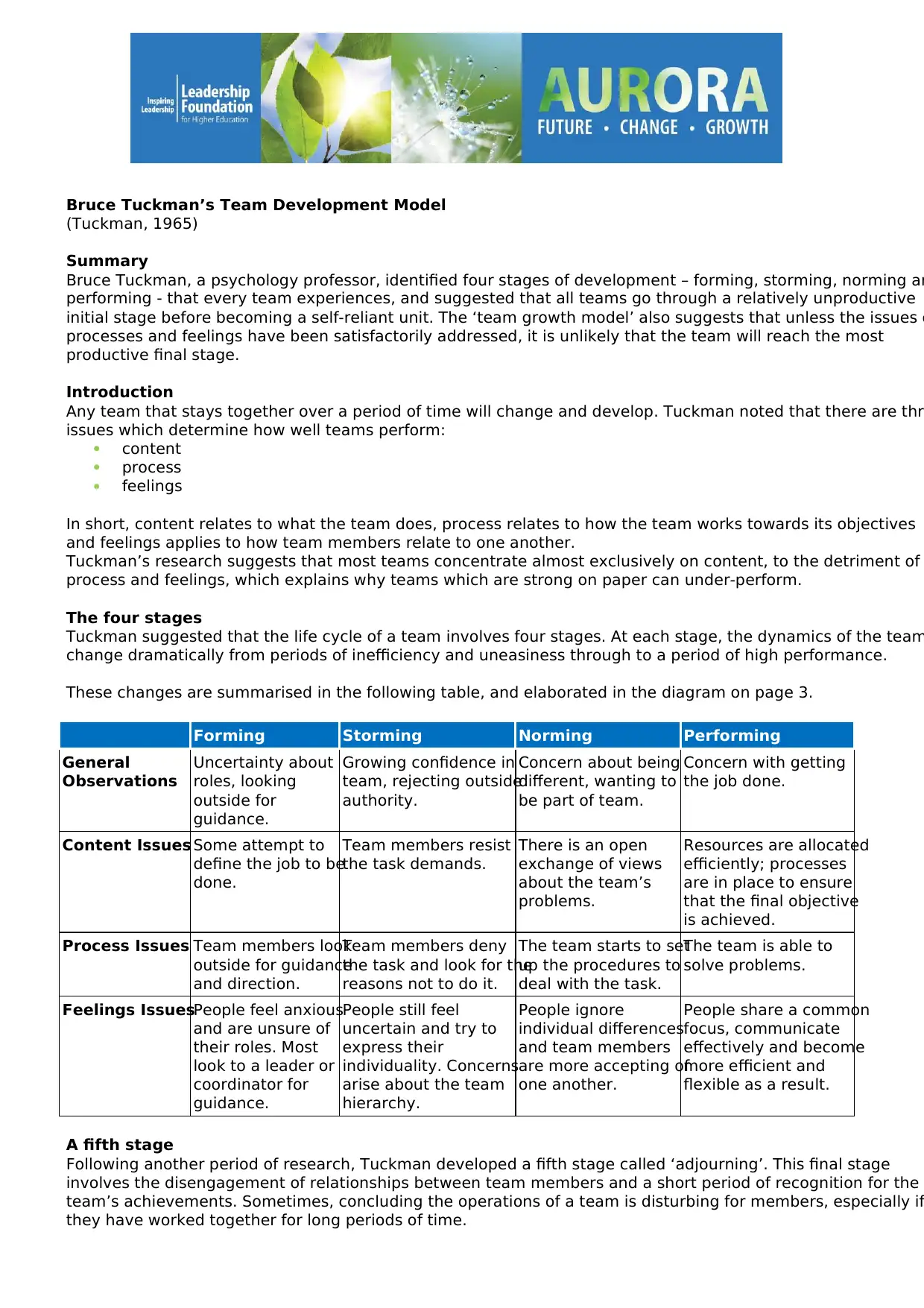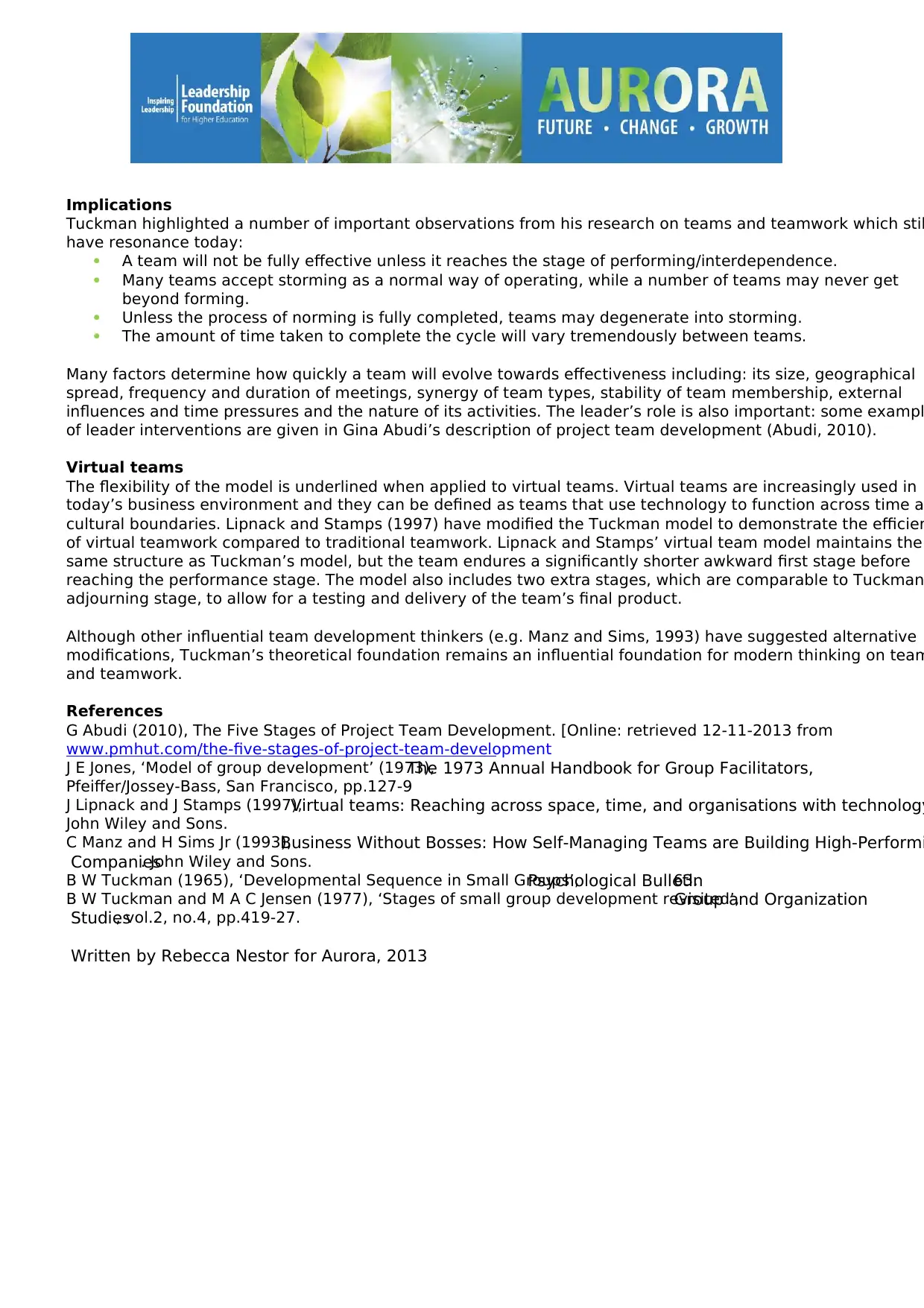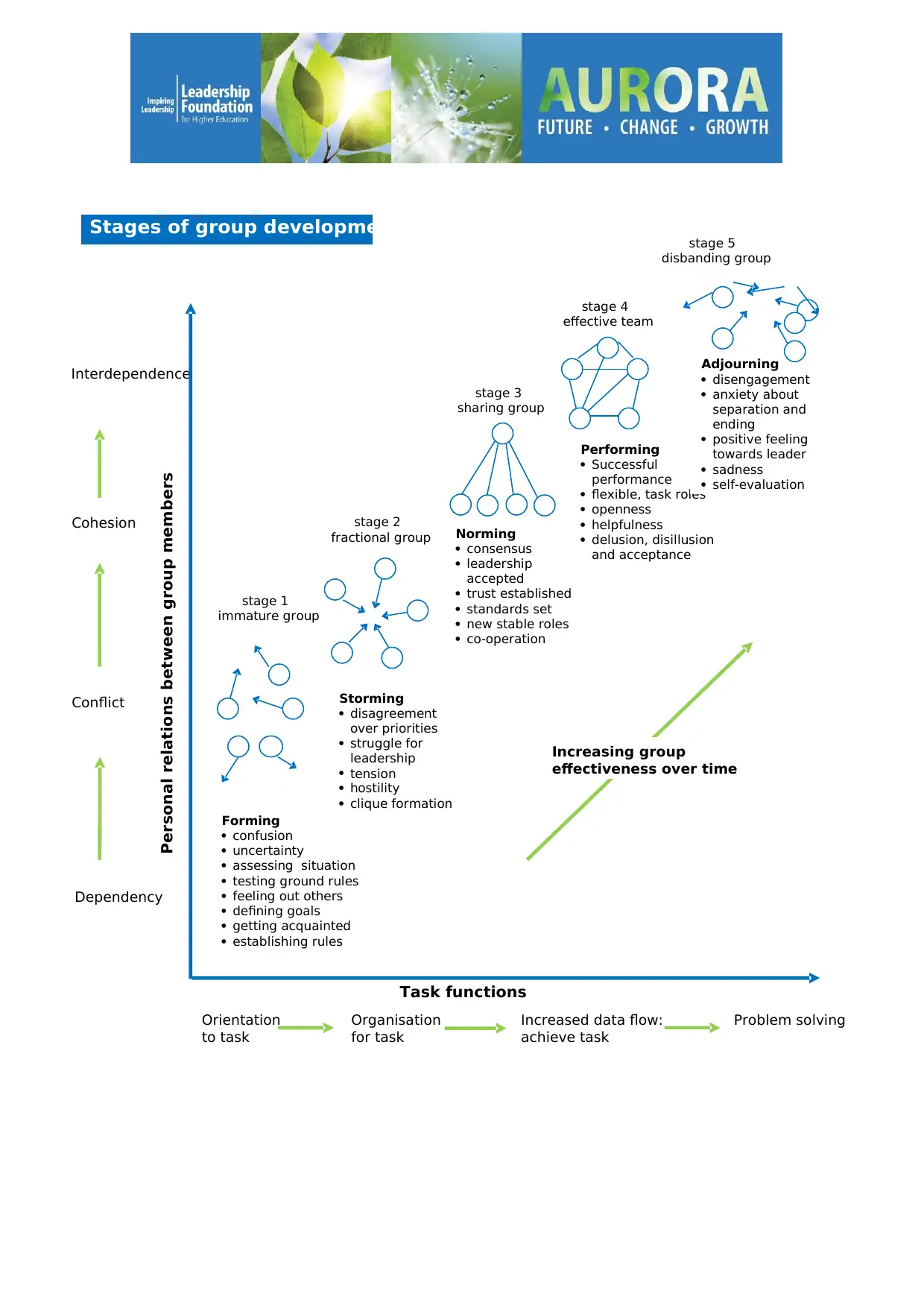Applying Tuckman's Model: A Reflective Case Study on Team Dynamics
VerifiedAdded on 2023/04/25
|3
|1191
|113
Case Study
AI Summary
This case study provides an overview of Bruce Tuckman's Team Development Model, which outlines the four stages of team development: forming, storming, norming, and performing. It emphasizes the importance of addressing content, process, and feelings within a team for optimal performance. The study discusses each stage in detail, highlighting the dynamics and challenges teams face as they evolve. It also touches upon Tuckman's fifth stage, adjourning, and the implications of the model for virtual teams, referencing modifications by Lipnack and Stamps. The case study concludes by underscoring the enduring relevance of Tuckman's framework in understanding and managing team dynamics.

Bruce Tuckman’s Team Development Model
(Tuckman, 1965)
Summary
Bruce Tuckman, a psychology professor, identified four stages of development – forming, storming, norming an
performing - that every team experiences, and suggested that all teams go through a relatively unproductive
initial stage before becoming a self-reliant unit. The ‘team growth model’ also suggests that unless the issues o
processes and feelings have been satisfactorily addressed, it is unlikely that the team will reach the most
productive final stage.
Introduction
Any team that stays together over a period of time will change and develop. Tuckman noted that there are thr
issues which determine how well teams perform:
content
process
feelings
In short, content relates to what the team does, process relates to how the team works towards its objectives
and feelings applies to how team members relate to one another.
Tuckman’s research suggests that most teams concentrate almost exclusively on content, to the detriment of
process and feelings, which explains why teams which are strong on paper can under-perform.
The four stages
Tuckman suggested that the life cycle of a team involves four stages. At each stage, the dynamics of the team
change dramatically from periods of inefficiency and uneasiness through to a period of high performance.
These changes are summarised in the following table, and elaborated in the diagram on page 3.
Forming Storming Norming Performing
General
Observations
Uncertainty about
roles, looking
outside for
guidance.
Growing confidence in
team, rejecting outside
authority.
Concern about being
different, wanting to
be part of team.
Concern with getting
the job done.
Content Issues Some attempt to
define the job to be
done.
Team members resist
the task demands.
There is an open
exchange of views
about the team’s
problems.
Resources are allocated
efficiently; processes
are in place to ensure
that the final objective
is achieved.
Process Issues Team members look
outside for guidance
and direction.
Team members deny
the task and look for the
reasons not to do it.
The team starts to set
up the procedures to
deal with the task.
The team is able to
solve problems.
Feelings IssuesPeople feel anxious
and are unsure of
their roles. Most
look to a leader or
coordinator for
guidance.
People still feel
uncertain and try to
express their
individuality. Concerns
arise about the team
hierarchy.
People ignore
individual differences
and team members
are more accepting of
one another.
People share a common
focus, communicate
effectively and become
more efficient and
flexible as a result.
A fifth stage
Following another period of research, Tuckman developed a fifth stage called ‘adjourning’. This final stage
involves the disengagement of relationships between team members and a short period of recognition for the
team’s achievements. Sometimes, concluding the operations of a team is disturbing for members, especially if
they have worked together for long periods of time.
(Tuckman, 1965)
Summary
Bruce Tuckman, a psychology professor, identified four stages of development – forming, storming, norming an
performing - that every team experiences, and suggested that all teams go through a relatively unproductive
initial stage before becoming a self-reliant unit. The ‘team growth model’ also suggests that unless the issues o
processes and feelings have been satisfactorily addressed, it is unlikely that the team will reach the most
productive final stage.
Introduction
Any team that stays together over a period of time will change and develop. Tuckman noted that there are thr
issues which determine how well teams perform:
content
process
feelings
In short, content relates to what the team does, process relates to how the team works towards its objectives
and feelings applies to how team members relate to one another.
Tuckman’s research suggests that most teams concentrate almost exclusively on content, to the detriment of
process and feelings, which explains why teams which are strong on paper can under-perform.
The four stages
Tuckman suggested that the life cycle of a team involves four stages. At each stage, the dynamics of the team
change dramatically from periods of inefficiency and uneasiness through to a period of high performance.
These changes are summarised in the following table, and elaborated in the diagram on page 3.
Forming Storming Norming Performing
General
Observations
Uncertainty about
roles, looking
outside for
guidance.
Growing confidence in
team, rejecting outside
authority.
Concern about being
different, wanting to
be part of team.
Concern with getting
the job done.
Content Issues Some attempt to
define the job to be
done.
Team members resist
the task demands.
There is an open
exchange of views
about the team’s
problems.
Resources are allocated
efficiently; processes
are in place to ensure
that the final objective
is achieved.
Process Issues Team members look
outside for guidance
and direction.
Team members deny
the task and look for the
reasons not to do it.
The team starts to set
up the procedures to
deal with the task.
The team is able to
solve problems.
Feelings IssuesPeople feel anxious
and are unsure of
their roles. Most
look to a leader or
coordinator for
guidance.
People still feel
uncertain and try to
express their
individuality. Concerns
arise about the team
hierarchy.
People ignore
individual differences
and team members
are more accepting of
one another.
People share a common
focus, communicate
effectively and become
more efficient and
flexible as a result.
A fifth stage
Following another period of research, Tuckman developed a fifth stage called ‘adjourning’. This final stage
involves the disengagement of relationships between team members and a short period of recognition for the
team’s achievements. Sometimes, concluding the operations of a team is disturbing for members, especially if
they have worked together for long periods of time.
Paraphrase This Document
Need a fresh take? Get an instant paraphrase of this document with our AI Paraphraser

Implications
Tuckman highlighted a number of important observations from his research on teams and teamwork which stil
have resonance today:
A team will not be fully effective unless it reaches the stage of performing/interdependence.
Many teams accept storming as a normal way of operating, while a number of teams may never get
beyond forming.
Unless the process of norming is fully completed, teams may degenerate into storming.
The amount of time taken to complete the cycle will vary tremendously between teams.
Many factors determine how quickly a team will evolve towards effectiveness including: its size, geographical
spread, frequency and duration of meetings, synergy of team types, stability of team membership, external
influences and time pressures and the nature of its activities. The leader’s role is also important: some exampl
of leader interventions are given in Gina Abudi’s description of project team development (Abudi, 2010).
Virtual teams
The flexibility of the model is underlined when applied to virtual teams. Virtual teams are increasingly used in
today’s business environment and they can be defined as teams that use technology to function across time a
cultural boundaries. Lipnack and Stamps (1997) have modified the Tuckman model to demonstrate the efficien
of virtual teamwork compared to traditional teamwork. Lipnack and Stamps’ virtual team model maintains the
same structure as Tuckman’s model, but the team endures a significantly shorter awkward first stage before
reaching the performance stage. The model also includes two extra stages, which are comparable to Tuckman
adjourning stage, to allow for a testing and delivery of the team’s final product.
Although other influential team development thinkers (e.g. Manz and Sims, 1993) have suggested alternative
modifications, Tuckman’s theoretical foundation remains an influential foundation for modern thinking on team
and teamwork.
References
G Abudi (2010), The Five Stages of Project Team Development. [Online: retrieved 12-11-2013 from
www.pmhut.com/the-five-stages-of-project-team-development
J E Jones, ‘Model of group development’ (1973),The 1973 Annual Handbook for Group Facilitators,
Pfeiffer/Jossey-Bass, San Francisco, pp.127-9
J Lipnack and J Stamps (1997),Virtual teams: Reaching across space, time, and organisations with technology.
John Wiley and Sons.
C Manz and H Sims Jr (1993),Business Without Bosses: How Self-Managing Teams are Building High-Performi
Companies. John Wiley and Sons.
B W Tuckman (1965), ‘Developmental Sequence in Small Groups’,Psychological Bulletin63.
B W Tuckman and M A C Jensen (1977), ‘Stages of small group development revisited’,Group and Organization
Studies, vol.2, no.4, pp.419-27.
Written by Rebecca Nestor for Aurora, 2013
Tuckman highlighted a number of important observations from his research on teams and teamwork which stil
have resonance today:
A team will not be fully effective unless it reaches the stage of performing/interdependence.
Many teams accept storming as a normal way of operating, while a number of teams may never get
beyond forming.
Unless the process of norming is fully completed, teams may degenerate into storming.
The amount of time taken to complete the cycle will vary tremendously between teams.
Many factors determine how quickly a team will evolve towards effectiveness including: its size, geographical
spread, frequency and duration of meetings, synergy of team types, stability of team membership, external
influences and time pressures and the nature of its activities. The leader’s role is also important: some exampl
of leader interventions are given in Gina Abudi’s description of project team development (Abudi, 2010).
Virtual teams
The flexibility of the model is underlined when applied to virtual teams. Virtual teams are increasingly used in
today’s business environment and they can be defined as teams that use technology to function across time a
cultural boundaries. Lipnack and Stamps (1997) have modified the Tuckman model to demonstrate the efficien
of virtual teamwork compared to traditional teamwork. Lipnack and Stamps’ virtual team model maintains the
same structure as Tuckman’s model, but the team endures a significantly shorter awkward first stage before
reaching the performance stage. The model also includes two extra stages, which are comparable to Tuckman
adjourning stage, to allow for a testing and delivery of the team’s final product.
Although other influential team development thinkers (e.g. Manz and Sims, 1993) have suggested alternative
modifications, Tuckman’s theoretical foundation remains an influential foundation for modern thinking on team
and teamwork.
References
G Abudi (2010), The Five Stages of Project Team Development. [Online: retrieved 12-11-2013 from
www.pmhut.com/the-five-stages-of-project-team-development
J E Jones, ‘Model of group development’ (1973),The 1973 Annual Handbook for Group Facilitators,
Pfeiffer/Jossey-Bass, San Francisco, pp.127-9
J Lipnack and J Stamps (1997),Virtual teams: Reaching across space, time, and organisations with technology.
John Wiley and Sons.
C Manz and H Sims Jr (1993),Business Without Bosses: How Self-Managing Teams are Building High-Performi
Companies. John Wiley and Sons.
B W Tuckman (1965), ‘Developmental Sequence in Small Groups’,Psychological Bulletin63.
B W Tuckman and M A C Jensen (1977), ‘Stages of small group development revisited’,Group and Organization
Studies, vol.2, no.4, pp.419-27.
Written by Rebecca Nestor for Aurora, 2013

Dependency
stage 2
fractional group
Interdependence
Personal relations between group members
Forming
confusion
uncertainty
assessing situation
testing ground rules
feeling out others
defining goals
getting acquainted
establishing rules
Storming
disagreement
over priorities
struggle for
leadership
tension
hostility
clique formation
Cohesion
Conflict
stage 1
immature group
stage 3
sharing group
stage 4
effective team
Performing
Successful
performance
flexible, task roles
openness
helpfulness
delusion, disillusion
and acceptance
Norming
consensus
leadership
accepted
trust established
standards set
new stable roles
co-operation
Adjourning
disengagement
anxiety about
separation and
ending
positive feeling
towards leader
sadness
self-evaluation
Task functions
Orientation
to task
Organisation
for task
Increased data flow:
achieve task
Problem solving
Increasing group
effectiveness over time
Stages of group development stage 5
disbanding group
stage 2
fractional group
Interdependence
Personal relations between group members
Forming
confusion
uncertainty
assessing situation
testing ground rules
feeling out others
defining goals
getting acquainted
establishing rules
Storming
disagreement
over priorities
struggle for
leadership
tension
hostility
clique formation
Cohesion
Conflict
stage 1
immature group
stage 3
sharing group
stage 4
effective team
Performing
Successful
performance
flexible, task roles
openness
helpfulness
delusion, disillusion
and acceptance
Norming
consensus
leadership
accepted
trust established
standards set
new stable roles
co-operation
Adjourning
disengagement
anxiety about
separation and
ending
positive feeling
towards leader
sadness
self-evaluation
Task functions
Orientation
to task
Organisation
for task
Increased data flow:
achieve task
Problem solving
Increasing group
effectiveness over time
Stages of group development stage 5
disbanding group
⊘ This is a preview!⊘
Do you want full access?
Subscribe today to unlock all pages.

Trusted by 1+ million students worldwide
1 out of 3
Related Documents
Your All-in-One AI-Powered Toolkit for Academic Success.
+13062052269
info@desklib.com
Available 24*7 on WhatsApp / Email
![[object Object]](/_next/static/media/star-bottom.7253800d.svg)
Unlock your academic potential
Copyright © 2020–2025 A2Z Services. All Rights Reserved. Developed and managed by ZUCOL.





